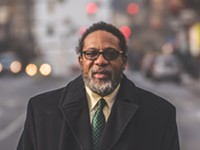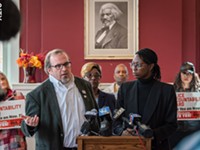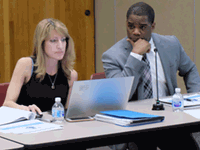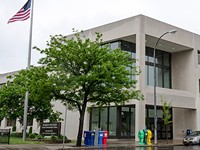[
{
"name": "500x250 Ad",
"insertPoint": "5",
"component": "15667920",
"parentWrapperClass": "",
"requiredCountToDisplay": "1"
}
]
It's tempting to feel optimistic about some of the things happening in Rochester, especially in a spring like this one, with the weather in the 70's and neighborhoods throughout the city awash in flowers. The Midtown site is getting ready for new streets (and, we hope, new development), stories keep trickling in about new businesses opening and new developments planned, the Jazz Festival is just six weeks away....
And then we get a wake-up call like "The State of Black Rochester 2013."
The book, issued last week by the Rochester Area Community Foundation's African American Giving Initiative, is patterned after the National Urban League's important "State of Black America" reports. Like the national surveys, the Rochester book details the status of African Americans in a variety of key areas. And there's little good news to be found.
As City Council member Dana Miller notes in his preface to the Rochester report, "Although the nation has re-elected the country's first African American president, the economic realities for many African Americans, especially young men, remain bleak."
Here are some of the statistics, drawn from studies by ACT Rochester, the Community Foundation's program that assesses key local data:
About 32 percent of blacks and Hispanics in the Rochester region live in poverty.
The regional poverty rate for children is worse: 44 percent for blacks and 39 percent for Hispanics, compared to 11 percent for whites. And in the City of Rochester, according to ACT's 2006-2010 data, nearly 50 percent of black children and more than 50 percent of Hispanic children are poor. The figure for white children – more than 30 percent – was better, but the three totals together underscore the growing concentration of poverty in the city.
In 2011, only 32 percent of Hispanic children and 29 percent of black children passed fourth-grade math tests. Only 26 percent of black children and 28 percent of Hispanic children passed fourth-grade English tests.
And in eighth grade, the news was worse: Only 16 percent of blacks and 20 percent of Hispanics passed English tests.
In 2006-2010, African Americans in the city spent 51 percent of their income on rent, Hispanics 55 percent. The median household income for African Americans in the region was 52 percent that of white households.
From Rochester Police Chief James Sheppard: Sixty-six percent of the arrests in the city in 2011 were of blacks; 78 percent of those arrested for violent crimes were black. Fifty-seven percent of the violent-crime victims were black. Seventy-five percent of the city's violent crimes took place in mostly-black neighborhoods. And most of the city's homicides were young black males killing other young black males.
Wade Norwood of the Finger Lakes Health Systems Agency offers these statistics in his chapter on the health of the region's African Americans: More of them are obese than are Hispanics or whites; more of them smoke; more die of diabetes, heart disease, and HIV/AIDS. More are hospitalized for substance abuse.
In the section on education, Rochester Superintendent Bolgen Vargas offers what to me is the most ominous information:
In Rochester's elementary schools, "African American students are not meeting any of the state standards in the areas of English, math, science or social studies." Neither, in fact, are Hispanic children. Only white children are.
And, writes Vargas, "this gap in academic achievement is strongly associated with race, ethnicity, social-economic background, and family and neighborhood stability," which are having a major, negative effect on children's achievement in school.
"If this is left unaddressed," writes Vargas, "the Rochester community can't prosper, given that a significant proportion of the future growth of the population is projected to be largely African American and Latino."
In their section on economic development, Clay Osborne, president of True Insights Consulting, and Eltrex CEO Matt Augustine write of two different Rochesters. One, they say, is "vibrant, hopeful, functional, wealthy, and highly livable." The other is "a deeply disenfranchised community represented by escalating poverty, social and community dysfunction, burgeoning unemployment, and economic adversity aggravated by a deficient educational system that breeds sustained underperformance."
And that Rochester, Osborne and Augustine say, correctly, is "reflective of an 'American Nightmare' from which we cannot awaken."
The book addresses the documented racial discrimination that continues to exist in employment, in housing, in zoning regulations, in lending. And Action for a Better Community CEO James Norman reminds us that the discrimination and the disparities can be traced back to slavery, and, more recently, to government-sanctioned racial segregation.
It is a depressing, and terribly important book. It is written, in part, as Dana Miller notes in his preface, to help the community determine "where to focus its giving to provide the greatest impact."
Rochester is historically a generous, concerned community. The information that this new book lays out isn't new. And we're a small enough, engaged enough community that we ought to be able to take this information and act on it – effectively.
I worry, though, that in her foreword to the book, Rochester Community Foundation CEO Jennifer Leonard has singled out a terrible truth about the Greater Rochester area.
"Though the racial inequities that Rochester faces, as documented in this book, reflect national trends," Leonard writes, "ours are in many cases worse – driven, I believe, by a persistent disinclination either to address them or to find out how to do so."
Concentrated poverty, poor education, racial discrimination: all of these have been at work, and this new book shows us the result. It's not just a "city" problem; it's affecting all of us. And all of us have to be willing to address it.
I'll come back to some of the topics raised in "The State of Black Rochester" in future columns. Meantime, get the book. It's on sale at Mood Makers in Village Gate (and on Amazon, but you ought to support a local business, particularly, in light of the economic concerns laid out in this book, a black owned business).
Despite the re-election of our first African American president, "the economic realities for many African Americans, especially young men, remain bleak." – Dana Miller
Speaking of...
-

RCSD students to lose role models with cutting of black, Latino teachers
Dec 17, 2019 -

Education forum tomorrow night for downtown residents
Sep 17, 2019 -

Perspectives: Jerome Underwood
Jan 16, 2019 - More »
Latest in Urban Journal
More by Mary Anna Towler
-

Police reform: advocates on what should come next
Oct 22, 2019 -

Court clears the way for Police Accountability referendum
Oct 17, 2019 -

Dade outlines initial actions on district deficit
Oct 9, 2019 - More »






